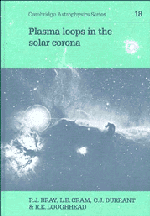Book contents
- Frontmatter
- Contents
- Preface
- Acknowledgements
- Other books by the authors
- List of abbreviations
- 1 Historical introduction
- 2 Cool loops: observed properties
- 3 Hot loops: observed properties
- 4 Flare loops: observed properties
- 5 Structure, dynamics and heating of loops
- 6 The plasma loop model of the coronae of the Sun and stars
- Additional notes
- Name index
- Subject index
2 - Cool loops: observed properties
Published online by Cambridge University Press: 22 October 2009
- Frontmatter
- Contents
- Preface
- Acknowledgements
- Other books by the authors
- List of abbreviations
- 1 Historical introduction
- 2 Cool loops: observed properties
- 3 Hot loops: observed properties
- 4 Flare loops: observed properties
- 5 Structure, dynamics and heating of loops
- 6 The plasma loop model of the coronae of the Sun and stars
- Additional notes
- Name index
- Subject index
Summary
Introduction
Coronal loops are a phenomenon of active regions (Chapter 1) and there is growing evidence that they are in fact the dominant structures in the higher levels (inner corona) of the Sun's atmosphere. Our knowledge of loops has greatly expanded in recent years as a result of space observations in the far ultraviolet and X-ray regions of the spectrum. However, the success of the space work should not be allowed to obscure the fact that a considerable amount of quantitative information on the morphological, dynamical, and physical properties of coronal loops has been derived from ground-based observations in the visible and near-visible regions. In fact, observations at these wavelengths have achieved significantly higher spatial resolution (better than 1″ of arc) than almost all of the space observations so far obtained. Our aim in this and the following chapter is to bring together all the available data and thus present an integrated and consistent picture of the properties of non-flare coronal loops.
Observations show that coronal loops, depending on their temperature, can be divided into two distinct categories. The properties of the two types differ radically. Loops formed at temperatures in excess of ∼ 1 × 106 K are conventionally referred to as ‘hot’ loops, while those formed at lower temperatures are termed ‘cool’ loops. It is convenient to deal with the two types separately, cool loops in the present chapter and hot loops in Chapter 3.
- Type
- Chapter
- Information
- Plasma Loops in the Solar Corona , pp. 27 - 91Publisher: Cambridge University PressPrint publication year: 1991



